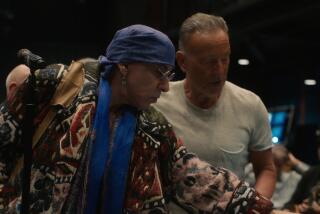Of Texas troubadours and Steve Earle
Thereâs a bit of Brâer Rabbit and the briar patch aspect to Steve Earleâs current album, âTownes,â his tribute to fellow Texas singer and songwriter Townes Van Zandt.
Fans who turn out to see him, like those at the Troubadour on Saturday for the second of his three nights at the West Hollywood club, shout any number of requests for Earleâs own songs, but he keeps returning to the songs by his youthful hero, who later turned into his mentor. After all, he has to do his duty and promote the album, right?
Clearly, there was not an ounce of obligation in that task, which occupied nearly half of his two-hour solo set. Earle, like so many other modern-day troubadours, worships at the altar of Van Zandtâs keenly observed tales of lifeâs wanderers and truth seekers.
Earle is so reverential on the album that the songs sometimes flounder under the weight of good intentions, but live, Earle was able to better inject the empathetic spirit that Van Zandt built into songs that often chart the wrong turns that hapless humans so often take in life.
For a while, Van Zandt also served as a role model in self-destructiveness that contributed to what Earle described as âa rough spotâ of drug addiction that led to jail time nearly two decades ago. But since kicking his habit about 15 years ago, heâs been able to reconnect with his muse and return to his place as one of alt-countryâs finest songwriters.
On Saturday, he also showed off a voice that was considerably stronger and notably less shredded than the one he used several years ago when he came through town for a show at the Greek Theatre.
With his slicked-back collar-length hair, spectacles and a shaggy beard approaching Smith Bros. dimension, Earle at 54 looks like a college poli-sci professor on sabbatical. He periodically sounded like one too, touching on the ramifications of President Obamaâs Nobel Peace Prize, the debate over efforts to reduce U.S. dependence on oil through the use of whatâs been touted as âclean-coal technologyâ and English-only legislation in public schools.
Thatâs an inextricable part of his music, which typically focuses on the human impact of politics. In some songs, he weaves them seamlessly, as with âCity of Immigrantsâ from his 2007 âWashington Square Serenadeâ album that grew out of his move several years ago from Nashville to New York City.
Livinâ in a city that never sleeps
My heart keepinâ time to a thousand beats
Singinâ in languages I donât speak
Livinâ in a city of immigrants ...
It was a celebration of the melting pot that came to a climax at the end of his show, when he brought opening act Tom Morello out for a full-fledged hootenanny treatment of Woody Guthrieâs âThis Land Is Your Land,â including the more pointed verses that are usually omitted in school assembly singalongs.
His choice of the Rage Against the Machine/the Nightwatchman singer-songwriter-guitarist completed the eveningâs rabble-rouser quotient. Morello also used the Troubadour stage as a melodic and rhythmic pulpit.
Neil Young recently said that, contrary to the mantra that began in the â60s, he no longer thinks pop music or musicians can change the world. Earle and Morello seem happy to have missed that memo.
--
More to Read
The biggest entertainment stories
Get our big stories about Hollywood, film, television, music, arts, culture and more right in your inbox as soon as they publish.
You may occasionally receive promotional content from the Los Angeles Times.










